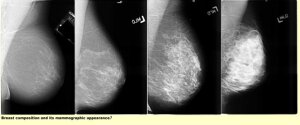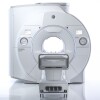Mayo Researchers Find Potential Links Between Breast Density and Breast Cancer Risk
by Barbara Kram, Editor | January 14, 2009

Dense breast
breast cancer risk
breast cancer risk
SAN ANTONIO - Having dense breasts - areas that show up light on a mammogram - is strongly associated with increased breast cancer risk, but "why" remains to be answered. Now, by examining dense and non-dense tissue taken from the breasts of healthy volunteers, researchers from Mayo Clinic have found several potential links.
In two studies being presented simultaneously in poster form at the Cancer Therapy & Research Center-American Association for Cancer Research (CTRC-AACR) San Antonio Breast Cancer Symposium, the researchers reported that dense breast tissue contains more cells believed to give rise to breast cancer, compared to non-dense tissue. "We found a dramatic difference in tissue composition between dense and non-dense tissue in the breast," says Karthik Ghosh, M.D., a Mayo Clinic breast cancer researcher and physician who led one study.
In a second study, researchers also found that dense breast tissue has more aromatase enzyme than non-dense tissue. This is significant because aromatase helps convert androgen hormones into estrogen, and estrogen is important in breast cancer development, says that study's lead investigator, Celine Vachon, Ph.D.
"If aromatase is differentially expressed in dense and non-dense breast tissue, this could provide one mechanism by which density may increase breast cancer risk," Dr. Vachon says.
The researchers say these findings are unique because these studies are the first to examine areas of both dense and non-dense tissue taken from the same breast in healthy volunteers. Examination of healthy women is important, Dr. Ghosh says, because most prior studies of breast density have looked at tissue taken from women with known breast disease.
Sixty women, age 40 to 85, allowed Mayo Clinic researchers to take eight core-needle biopsies from their breasts; none had a history of breast cancer.
Dr. Ghosh and her team examined the biopsies to determine the percentage of epithelium tissue, stroma, and fat content in each. The epithelium is primarily composed of milk glands and ductal cells, and stroma is the connective tissue that supports epithelial cells. Dr. Vachon and her colleagues looked at aromatase expression within cells in both dense and non-dense tissue.
Results are now available from more than half of the participants who donated biopsy tissue. Dr. Ghosh found that areas of density contained much more epithelium (6 percent) and stroma (64 percent) and much less fat (30 percent), compared to non-dense tissue that contained less than 1 percent epithelium, about 20 percent stroma, and almost 80 percent fat. "This shows us that both the epithelium and stroma contribute to density, and suggests that the large difference in stroma content in dense breast tissue may play a significant role in breast cancer risk," Dr. Ghosh says.
In two studies being presented simultaneously in poster form at the Cancer Therapy & Research Center-American Association for Cancer Research (CTRC-AACR) San Antonio Breast Cancer Symposium, the researchers reported that dense breast tissue contains more cells believed to give rise to breast cancer, compared to non-dense tissue. "We found a dramatic difference in tissue composition between dense and non-dense tissue in the breast," says Karthik Ghosh, M.D., a Mayo Clinic breast cancer researcher and physician who led one study.
In a second study, researchers also found that dense breast tissue has more aromatase enzyme than non-dense tissue. This is significant because aromatase helps convert androgen hormones into estrogen, and estrogen is important in breast cancer development, says that study's lead investigator, Celine Vachon, Ph.D.
"If aromatase is differentially expressed in dense and non-dense breast tissue, this could provide one mechanism by which density may increase breast cancer risk," Dr. Vachon says.
The researchers say these findings are unique because these studies are the first to examine areas of both dense and non-dense tissue taken from the same breast in healthy volunteers. Examination of healthy women is important, Dr. Ghosh says, because most prior studies of breast density have looked at tissue taken from women with known breast disease.
Sixty women, age 40 to 85, allowed Mayo Clinic researchers to take eight core-needle biopsies from their breasts; none had a history of breast cancer.
Dr. Ghosh and her team examined the biopsies to determine the percentage of epithelium tissue, stroma, and fat content in each. The epithelium is primarily composed of milk glands and ductal cells, and stroma is the connective tissue that supports epithelial cells. Dr. Vachon and her colleagues looked at aromatase expression within cells in both dense and non-dense tissue.
Results are now available from more than half of the participants who donated biopsy tissue. Dr. Ghosh found that areas of density contained much more epithelium (6 percent) and stroma (64 percent) and much less fat (30 percent), compared to non-dense tissue that contained less than 1 percent epithelium, about 20 percent stroma, and almost 80 percent fat. "This shows us that both the epithelium and stroma contribute to density, and suggests that the large difference in stroma content in dense breast tissue may play a significant role in breast cancer risk," Dr. Ghosh says.
1(current)









